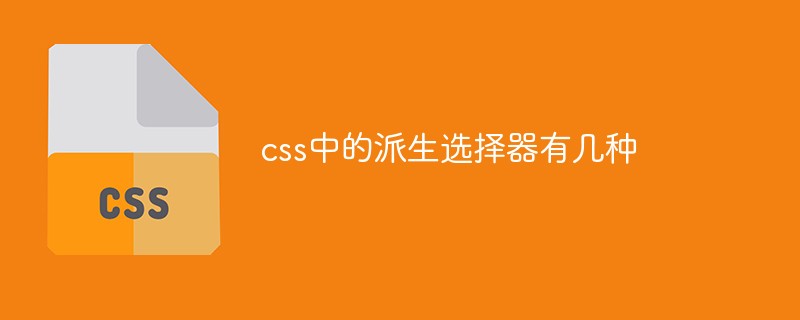There are several derived selectors in css
css中的派生选择器有3种:1、后代选择器,语法“E F{样式代码}”;2、子元素选择器,语法“E > F {样式代码}”;3、相邻兄弟选择器,语法“E + F {样式代码}”。

本教程操作环境:windows7系统、CSS3&&HTML5版、Dell G3电脑。
CSS之派生选择器(上下文选择器)
选择器(selector)是CSS里面非常重要地一部分知识。
根据我暂时浅薄地理解,CSS就是对一份HTML代码里面的元素进行运用各种样式。
所以,第一步就是要准确地定位你想要运用样式的元素。
CSS里面通过各种选择器来定位元素。 CSS里面选择器有很多种,今天就只想说说 “派生选择器”。
一听“派生选择器”这个名字,我真心做不到见名知义地感觉它是什么选择器。一看英文名叫“contextual selectors” ,如果直译就叫“上下文选择器”。虽然名字不文雅,但是我更偏向这个名字。
contexual selector是通过依据元素在其位置的上下文关系来定义样式的。
上下文选择器的情况有三种:后代选择器,子元素选择器,相邻兄弟选择器。
后代选择器(descendant selector)
eg:
HTML代码:
<h1>This is a<em>important</em>heading</h1>
CSS代码:
h1 em {color:red;}语法规则是 h1 和 em 之间有一个空格。那么这一条CSS代码就会运用于包含在
标签内的所有元素。关于后代选择器,很重要的一点是第一个参数和第二个参数之间的代数是可以无限的。
eg:
HTML代码:
<ul> <li> <ul> <li> <em>This will be styled.</em> </li> </ul> </li> <li> <em>This will be styled too.</em> </li> </ul>
CSS代码:
ul em{color:red;}以上css的样式会运用于HTML代码中两处橘色的元素。
子选择器(child selector)
子选择器只会选择某个元素的子元素,而不会扩大到任意的后代元素。
eg:
HTML代码:
<h1>This is <strong>This will be styled.</strong> important.</h1> <h1>This is <em>really <strong>This will not be styled.</strong></em> important.</h1>
CSS代码:
h1 > strong {color:red;}语法规则是h1和strong之间会有一个“>”符号。而这个“>”和前面的h1或者是后面的strong之间的空格都是可有可无的。
在以上的例子中,第一行HTML代码里,元素是的子元素,所有h1 > strong这个选择器会选择到它。
第二行HTML代码里, 不是的子元素,而是
的孙子,所有h1 > strong这个选择器不会选择到它。
相邻兄弟选择器(Adjacent sibling selector)
相邻兄弟选择器会选择某一元素紧随其后的元素,但是前提是他们拥有相同的父级。
eg:
HTML代码:
<h1> <h2>This is a heading<h2> <strong>This will be styled.</strong> <strong>This will not be styled.</strong> <h1>
CSS代码:
h2 + strong {color:red;}语法规则是h2和strong之间有一个“+”,“+”和前面的h1或者后面的strong之间的空格都是可有可无的。
在 以上例子中,第一个strong紧邻着h2并且他们拥有相同的父级(h1),所以h2 + strong会选择到第一个而不会选到第二个.
eg2:
HTML代码:
<p> <ul> <li>List item 1</li> <li>List item 2</li> <li>List item 3</li> </ul> <ol> <li>List item 1</li> <li>List item 2</li> <li>List item 3</li> </ol> </p>
CSS代码:
li + li {color:red;}在以上的例子中li+li是选择紧挨着li后面的第一个
(学习视频分享:css视频教程)
The above is the detailed content of There are several derived selectors in css. For more information, please follow other related articles on the PHP Chinese website!

Hot AI Tools

Undresser.AI Undress
AI-powered app for creating realistic nude photos

AI Clothes Remover
Online AI tool for removing clothes from photos.

Undress AI Tool
Undress images for free

Clothoff.io
AI clothes remover

Video Face Swap
Swap faces in any video effortlessly with our completely free AI face swap tool!

Hot Article

Hot Tools

Notepad++7.3.1
Easy-to-use and free code editor

SublimeText3 Chinese version
Chinese version, very easy to use

Zend Studio 13.0.1
Powerful PHP integrated development environment

Dreamweaver CS6
Visual web development tools

SublimeText3 Mac version
God-level code editing software (SublimeText3)

Hot Topics
 1665
1665
 14
14
 1423
1423
 52
52
 1321
1321
 25
25
 1269
1269
 29
29
 1249
1249
 24
24
 How to use bootstrap in vue
Apr 07, 2025 pm 11:33 PM
How to use bootstrap in vue
Apr 07, 2025 pm 11:33 PM
Using Bootstrap in Vue.js is divided into five steps: Install Bootstrap. Import Bootstrap in main.js. Use the Bootstrap component directly in the template. Optional: Custom style. Optional: Use plug-ins.
 Understanding HTML, CSS, and JavaScript: A Beginner's Guide
Apr 12, 2025 am 12:02 AM
Understanding HTML, CSS, and JavaScript: A Beginner's Guide
Apr 12, 2025 am 12:02 AM
WebdevelopmentreliesonHTML,CSS,andJavaScript:1)HTMLstructurescontent,2)CSSstylesit,and3)JavaScriptaddsinteractivity,formingthebasisofmodernwebexperiences.
 The Roles of HTML, CSS, and JavaScript: Core Responsibilities
Apr 08, 2025 pm 07:05 PM
The Roles of HTML, CSS, and JavaScript: Core Responsibilities
Apr 08, 2025 pm 07:05 PM
HTML defines the web structure, CSS is responsible for style and layout, and JavaScript gives dynamic interaction. The three perform their duties in web development and jointly build a colorful website.
 How to write split lines on bootstrap
Apr 07, 2025 pm 03:12 PM
How to write split lines on bootstrap
Apr 07, 2025 pm 03:12 PM
There are two ways to create a Bootstrap split line: using the tag, which creates a horizontal split line. Use the CSS border property to create custom style split lines.
 How to insert pictures on bootstrap
Apr 07, 2025 pm 03:30 PM
How to insert pictures on bootstrap
Apr 07, 2025 pm 03:30 PM
There are several ways to insert images in Bootstrap: insert images directly, using the HTML img tag. With the Bootstrap image component, you can provide responsive images and more styles. Set the image size, use the img-fluid class to make the image adaptable. Set the border, using the img-bordered class. Set the rounded corners and use the img-rounded class. Set the shadow, use the shadow class. Resize and position the image, using CSS style. Using the background image, use the background-image CSS property.
 How to set up the framework for bootstrap
Apr 07, 2025 pm 03:27 PM
How to set up the framework for bootstrap
Apr 07, 2025 pm 03:27 PM
To set up the Bootstrap framework, you need to follow these steps: 1. Reference the Bootstrap file via CDN; 2. Download and host the file on your own server; 3. Include the Bootstrap file in HTML; 4. Compile Sass/Less as needed; 5. Import a custom file (optional). Once setup is complete, you can use Bootstrap's grid systems, components, and styles to create responsive websites and applications.
 How to resize bootstrap
Apr 07, 2025 pm 03:18 PM
How to resize bootstrap
Apr 07, 2025 pm 03:18 PM
To adjust the size of elements in Bootstrap, you can use the dimension class, which includes: adjusting width: .col-, .w-, .mw-adjust height: .h-, .min-h-, .max-h-
 How to use bootstrap button
Apr 07, 2025 pm 03:09 PM
How to use bootstrap button
Apr 07, 2025 pm 03:09 PM
How to use the Bootstrap button? Introduce Bootstrap CSS to create button elements and add Bootstrap button class to add button text




